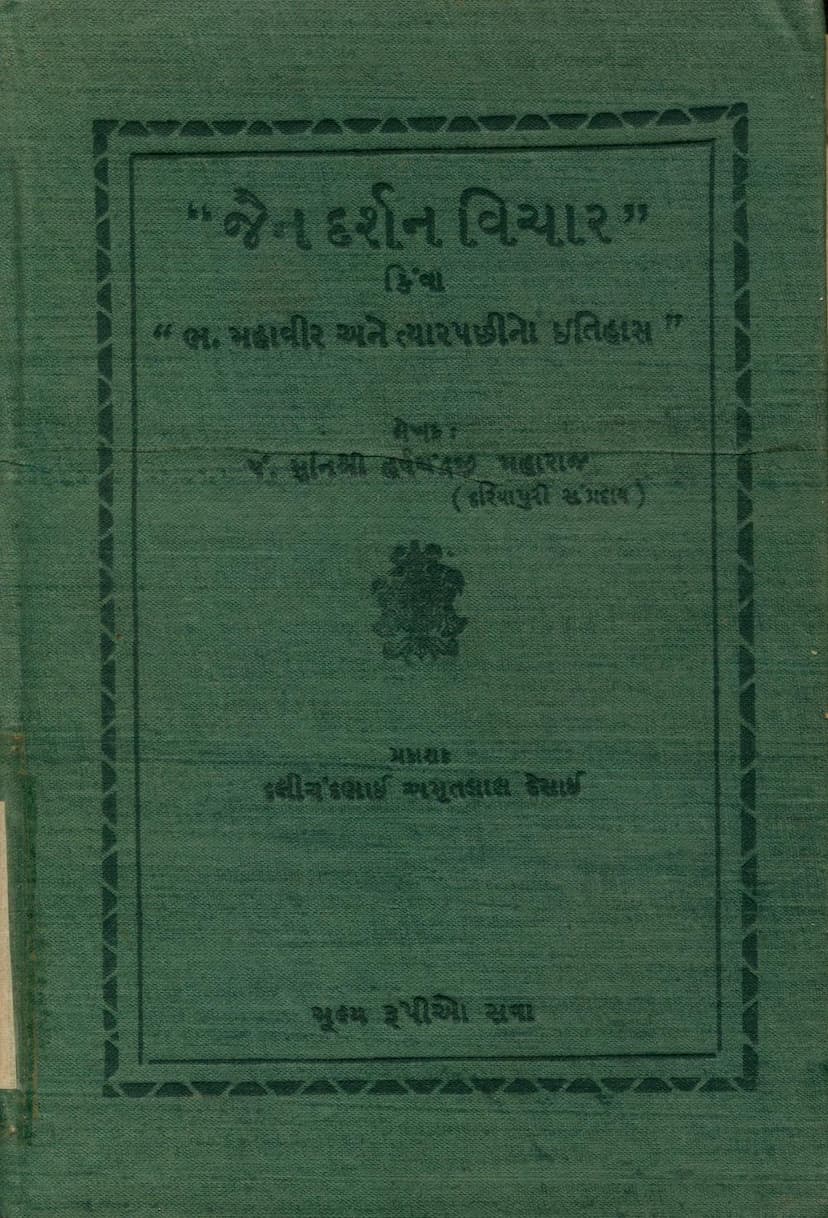Jain Darshan Vichar Kimva Bhagwan Mahavir Ane Tyar Pachino Itihas
Added to library: September 1, 2025

Summary
Here's a comprehensive summary of the Jain text "Jain Darshan Vichar Kimva Bhagwan Mahavir ane Tyar Pachino Itihas" (Jain Philosophy Discussion or Lord Mahavir and His Subsequent History) by Harshchandra Maharaj, based on the provided pages:
This book, published in 1950 (Veer Samvat 2476, Vikram Samvat 2006), is an exploration of Jain philosophy and history, with a particular focus on Lord Mahavir and the period following him. The author, Muni Shri Harshchandraji Maharaj of the Dariyapuri sect, presents a scholarly yet accessible discussion, drawing from a wide range of Jain and non-Jain literature.
Key Themes and Content:
-
Focus on Lord Mahavir and his Contemporaries: The book begins by detailing the life of Lord Mahavir, from his birth and early life to his renunciation and eventual attainment of Kevala Jnana (omniscience). It then delves into the philosophies and beliefs of his contemporary religious leaders, including:
- Makhali Gosala: His philosophy of fate and determinism, his concept of six classes of beings, and his views on purity and impurity are discussed, along with critical assessments from both Buddhist and Jain perspectives.
- Puran Kassapa: His belief that no action (good or bad) leads to sin or merit is examined, highlighting his anachronistic views and his classification of people into different "jati" (castes) based on their lifestyles.
- Kakkud Katayayan: His philosophy of eternalism and his belief in the unchanging nature of seven elements is presented.
- Ajit Kesakambali: His materialistic and atheistic views, aligning with Charvaka philosophy, are explored. He argued against the efficacy of rituals, donations, and asceticism, stating that after death, the five elements dissolve back into their respective elements, and nothing remains.
- Sanjaya Belatthiputta: His agnostic and skeptical stance, characterized by his refusal to give definitive answers to metaphysical questions and his evasionary tactics, is detailed.
- Gautama Buddha: The book discusses Buddha's life and teachings, his views on meat-eating, and his place within the broader ascetic movement of the time. It highlights the similarities and differences between Buddhist and Jain philosophies, particularly concerning the concept of karma and the ultimate goal of liberation.
-
History of Jain Traditions (Digambara and Shvetambara): A significant portion of the book is dedicated to tracing the historical development and divergence of the Digambara and Shvetambara traditions. This includes:
- Pattavalis (Genealogies of Spiritual Leaders): The book examines various "Pattavalis" (lists of succession of spiritual leaders) from Mathura and Valabhi to understand the lineage and compilation of Jain scriptures.
- Scriptural Traditions: It discusses the Digambara view of the loss of many Angas (canonical texts) and the preservation of certain texts like the "Shatkhandagama" and "Kashaya Pahud." Similarly, it outlines the Shvetambara canon, including the Angas and Upangas.
- Differences in Interpretation: The author highlights disagreements between the two sects regarding the interpretation of scriptures, particularly concerning the possibility of women attaining liberation (stri mukti), the consumption of food by Kevalis (omniscient beings), and the practice of wearing clothes (sachilakatva vs. achilakatva).
- Chronological Discrepancies: The book addresses the challenges in establishing precise timelines for ancient Jain figures and events, noting the conflicting accounts and interpretations in different traditions.
-
Analysis of "Samaysar" and its Philosophy: A substantial part of the book is dedicated to a critical analysis of the "Samaysar" text and the philosophical views attributed to its author, Kundakundacharya.
- Interpretation of Karma and Soul: The author scrutinizes Kundakundacharya's perspective on karma, the soul, and their interaction. He questions the idea that the soul is not the doer or experiencer of karma, and highlights the perceived contradictions in the text when compared to core Jain principles.
- Critique of "Akriya" (Inaction) and "Jnana" (Knowledge): The book discusses Kundakundacharya's emphasis on knowledge and detachment, questioning whether this de-emphasizes the importance of ethical conduct, asceticism, and the strict adherence to vows (like ahimsa) that are central to Jainism.
- Influence and Divergence: The author suggests that Kundakundacharya's views might have deviated from traditional Jain teachings, possibly influenced by other philosophical schools like Vedanta and Sankhya. The book points out that while Kundakundacharya is considered a prominent figure, his interpretations have led to debates and divisions within the Jain community.
-
Critique of Current Jain Practices: The book doesn't shy away from offering a critical perspective on certain contemporary practices within the Jain community.
- Inconsistency in Ahimsa: It highlights the perceived hypocrisy in adhering to strict ahimsa (non-violence) in some areas while engaging in violence (even to one-sensed beings) in temple rituals or other religious practices.
- Role of Ascetics: The author questions the conduct and motivations of some ascetics who, despite renouncing worldly life, seem to be entangled in worldly affairs or promoting practices that contradict the core principles of Jainism.
- Polemics between Sects: The book acknowledges the ongoing debates and animosity between different Jain sects (Digambara, Shvetambara, Sthanakavasi, Murtipujak), attributing much of it to pride, misunderstanding, and the misinterpretation of scriptures.
-
Importance of Scholar Analysis: The author emphasizes the need for critical and comparative analysis of all religious literature (Jain, Buddhist, Vedic) to arrive at a balanced understanding of historical and philosophical truths. He acknowledges the contributions of scholars like Dr. A.S. Gopani, who wrote the preface.
Overall Tone and Contribution:
The book is a deep dive into Jain philosophy and history, characterized by diligent research and a willingness to engage with complex theological and historical issues. While the author, Muni Harshchandraji Maharaj, expresses strong views and critiques, his approach is rooted in a desire to understand and present the truth as he perceives it. The book aims to stimulate thought, encourage critical inquiry, and ultimately contribute to a deeper appreciation of Jainism. The publisher, Dulichand Amrutlal Desai, made the book accessible by keeping its price minimal, aiming for wider readership.
This summary provides a structured overview of the book's content, covering its main arguments, historical analyses, and philosophical critiques.